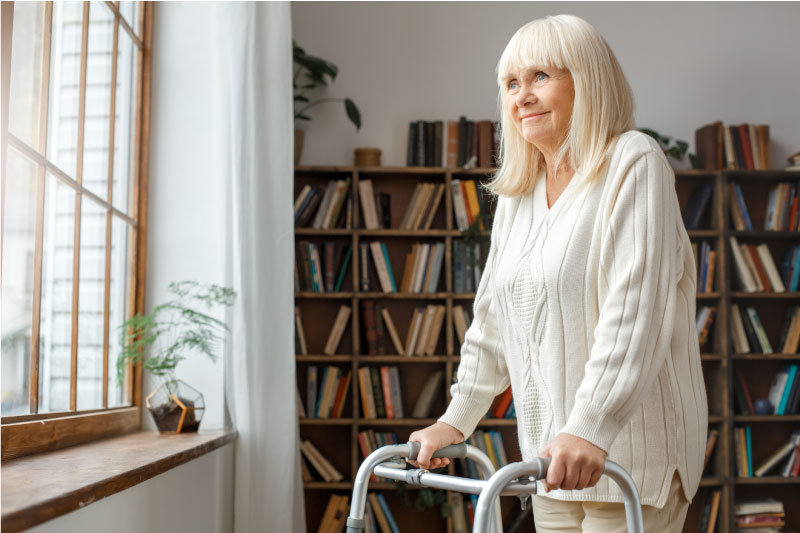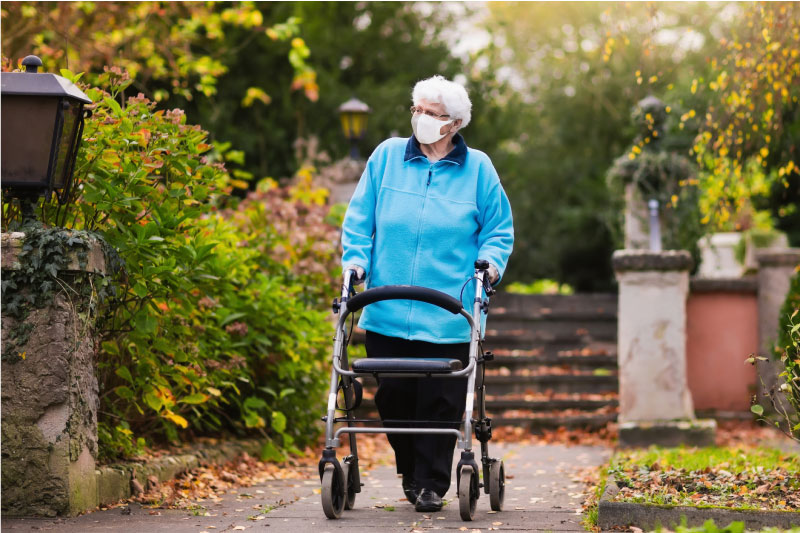
Are you struggling to choose the best walker for your senior or elderly loved one? It’s no wonder! Modern walkers and rollators have come a long way from the spartan walkers with basic metal frames most of us remember. Today’s models have many more features, and some are even suitable for rougher terrain.
In this article, we’ll help you understand the different types of walkers and sort through the options to select the best walker for your senior relative’s needs.
Types of Walkers

Walkers and rollators help people maintain their balance while moving around their homes or in other surroundings. The type of walker needed depends on an individual’s level of mobility.
- Standard walkers have a metal frame and four rubber-tipped feet. They’re the most basic type and offer the most support for people who have balance problems, unstable gait, and/or joint problems that make it difficult to bear weight on one side. Standard walkers require the user to have a reasonable amount of upper body strength and aren’t suitable for uneven terrain. Because the user must stop at intervals to lift the walker, place it forward, then walk forward, they only support relatively slow movement.
- Front-wheel rolling walkers support faster, more natural movements. They’re a good option for someone who can walk unassisted but has an unstable gait or balance problem. The two wheels are generally fixed in place and don’t swivel. This makes the walker more stable, but harder to maneuver around objects or in a crowd. Walking at a more natural pace is easier because the user only has to lift up the back legs of the walker to move forward. NOTE: front-wheel walker users must be careful to not push the walker too far in front and never use it to go up and down stairs.
- Three-wheel walkers are what you get when you a cross a two-wheel walker and a four-wheel rollator. These hybrid walkers have several advantages. They provide more mobility than standard walkers. The all-wheel design offers faster walking, and the single front wheel makes the walker easy to turn. They’re lighter weight than the four-wheeled rollators and take up less space. Most designs easily fit in a car trunk. However, three-wheel walkers aren’t designed for people who need a walker that supports their weight. Pushing down on the wheels may make the walker harder to steer.
- Four-wheel rollator walkers are often called “rolling walkers” but there’s an important difference between a rollator and a walker because the rollator also has a seat attachment. They’re designed as an aid for people who don’t need a balance aid, but need to rest frequently. Rollators are easy to steer because the wheels swivel, but they’re larger and heavier than standard or three-wheeled walkers. They may be hard to use in small homes or crowded spaces. NOTE: Rollators are more expensive than walkers and aren’t suitable for people who can’t support their own body weight.
Five Must-Have Walker Safety Features

Walker features range from the basic lightweight folding model to brightly-colored sporty versions with cup holders, phone chargers, and attractive attachments and carry pouches. Options are great, but make sure the walker you choose for your elderly relative has the safety features they require:
- Adjustable height: All walkers allow for some variation in height, but if your relative is unusually tall or short, make sure the height adjustment matches their needs.
- Weight capacity: Most walkers are rated for 250-300 pounds. Sturdy bariatric models can accommodate larger people.
- Portability: Lighter weight folding models are easier for users to manage on the go. Make sure your relative can manage the walker independently and understands how to safely store it and set it up for use.
- Wheel type: Outdoor activities help seniors sleep better, and may allievate isolation and depression. If your relative enjoys being outdoors, consider an all-terrain walker with larger, more durable wheels that can help them safely navigate uneven terrain.
- Brake type: Most walkers have hand-operated brakes what work when the user squeezes the handle. This might be difficult for people with arthritis or joint problems. They may be more comfortable (and safe) with a model with weight-activated brakes.
Walkers, rollators and even stair lifts are important safety devices that help seniors and the elderly avoid falls. Together with aging in place home modifications, they can help seniors stay independent.
But accidents can still happen! Falls are the leading cause of injuries to seniors and the elderly. A quarter of all seniors fall at least once each year. Many suffer injuries severe enough to send them to nursing homes or assisted living facilities.
GetSafe’s voice-enabled medical alert systems allow you to call for help by pushing a help button, pulling a cord, or simply telling the system to “Call 9-1-1” when you need help. Place our wall buttons in bathrooms, near stairs, and any areas that represent a fall hazard.
Our systems are affordable and easy to install. Call 1-888-799-6255 to learn how you can try one risk-free for 30 days.







